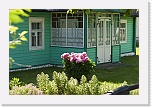<<- Main site
 Lusiai-järvi Auktaitijasin kansallispuistossa Liettuassa 7. - 11.6. 2011
Lusiai-järvi Auktaitijasin kansallispuistossa Liettuassa 7. - 11.6. 2011
Teimme kesäkuussa retken Liettuaan. Pääkohteita olivat Auktaitijasin kansallispuito Itä-Liettuassa ja Rusnen saari Kuurin lahden rannalla.
Edellisestä retkestä poiketen nyt oli tavattoman kuumaa. Lämpötila oli alkumatkasta jatkuvasti kolmenkymmenen asteen tuntumassa. Via Baltica Latvian eteläosissa oli kurjassa kunnossa. Siltatyö Bauskan kaupungissa jumitti pahasti matkan tekoa. Siksi päätimme yöpyä siellä. Perille Auktaijasiin ehdimme vasta seuraava iltana. Opastuskeskuksen toimihenkilö oli ystävällisesti järjestänyt meille majoituksen Lusiai-järven rannalta. Majapaikka oli monta pientä huonetta sisältävä hirsitalo. Päädyssä yhteiskeittiö. Paikka oli maiseman puolesta kaunis mutta kovemmat naapurin puheet kuuluivat seinien läpi.
Auktaitija esitellään kohtalaisena lintukohteena mutta siinä on paljon liioittelua. Puiston vartija osui kanssamme samaan aikaan puolilahoon lintutorniin ja kertoi rantojen vesakoituneen niin pahasti, etteivät ne suuremmin houkuttele muuttolintuja. Varoja puistolla taas ei ole tilanteen parantamiseen.
Muuten seutu on metsäistä kumpumaastoa ja siellä on lukuisia järviä. Se sopii hyvin retkeilyyn ja pyöräilyyn. Suomalaiselle maisemat ovat tutun oloisia, mutta lehtipuiden ansiosta jotenkin pehmeäpiirteisempiä. Seudun tunnetuin "nähtävyys" on Ignalinan ydinvoimala, joka tosin on nykyään suljettu. Se on kaukana korvessa puiston ulkopuolella lähellä Latvian rajaa, mutta saanut nimensä lähimmän kaupungin mukaan.
 Valokuvia
Valokuvia



 Lake Lusiai and Auktaitijos National Park 7th- 11th, June 2011.
Lake Lusiai and Auktaitijos National Park 7th- 11th, June 2011.
We made in June a trip to Lithuania. The main objectives were Auktaitijos national park in eastern Lithuania and Rusne Island on the shore of the Curonian bay.
As distinct from the previous trip it was now extremely hot. The temperature was in the beginning continuously near thirty degrees. The road Via Baltica in Latvia's southern parts was in miserable order. Bridge work in Bauska town hindered badly the trip. Therefore we decided to stay overnight there. To Auktaitijos we came only on the following evening. The employee of the guidance centre had kindly arranged an accommodation for us from the shore of the lake Lusiai. The lodging was a timber house which contains many small rooms. In other end was a kitchen for the use of all visitors. The place was beautiful for the landscape but harder neighbour's speeches were heard through the walls.
Auktaitijos is demonstrated as a moderate birding target but in it there is much exaggeration. The guard of the park hit a half rotten bird tower at the same time with us and told that the shores had coppiced so badly that they do not persuade migratory birds more greatly. The park, however, cannot afford the improvement of the situation.
Otherwise the region is a wooded hill terrain and there are numerous lakes there. It is well suitable for hiking and cycling. To the Finn the landscapes are quite familiar but somehow softer thanks to the deciduous trees. "The best known" sight of the region is however the nuclear power plant of Ignalina, which has been closed nowadays. It is near Latvia far in the woods outside the park, but had got its name according to the nearest town.
 Pictures
Pictures
 Lusiai-järvi Auktaitijasin kansallispuistossa Liettuassa 7. - 11.6. 2011
Lusiai-järvi Auktaitijasin kansallispuistossa Liettuassa 7. - 11.6. 2011 Valokuvia
Valokuvia
 Lake Lusiai and Auktaitijos National Park 7th- 11th, June 2011.
Lake Lusiai and Auktaitijos National Park 7th- 11th, June 2011.